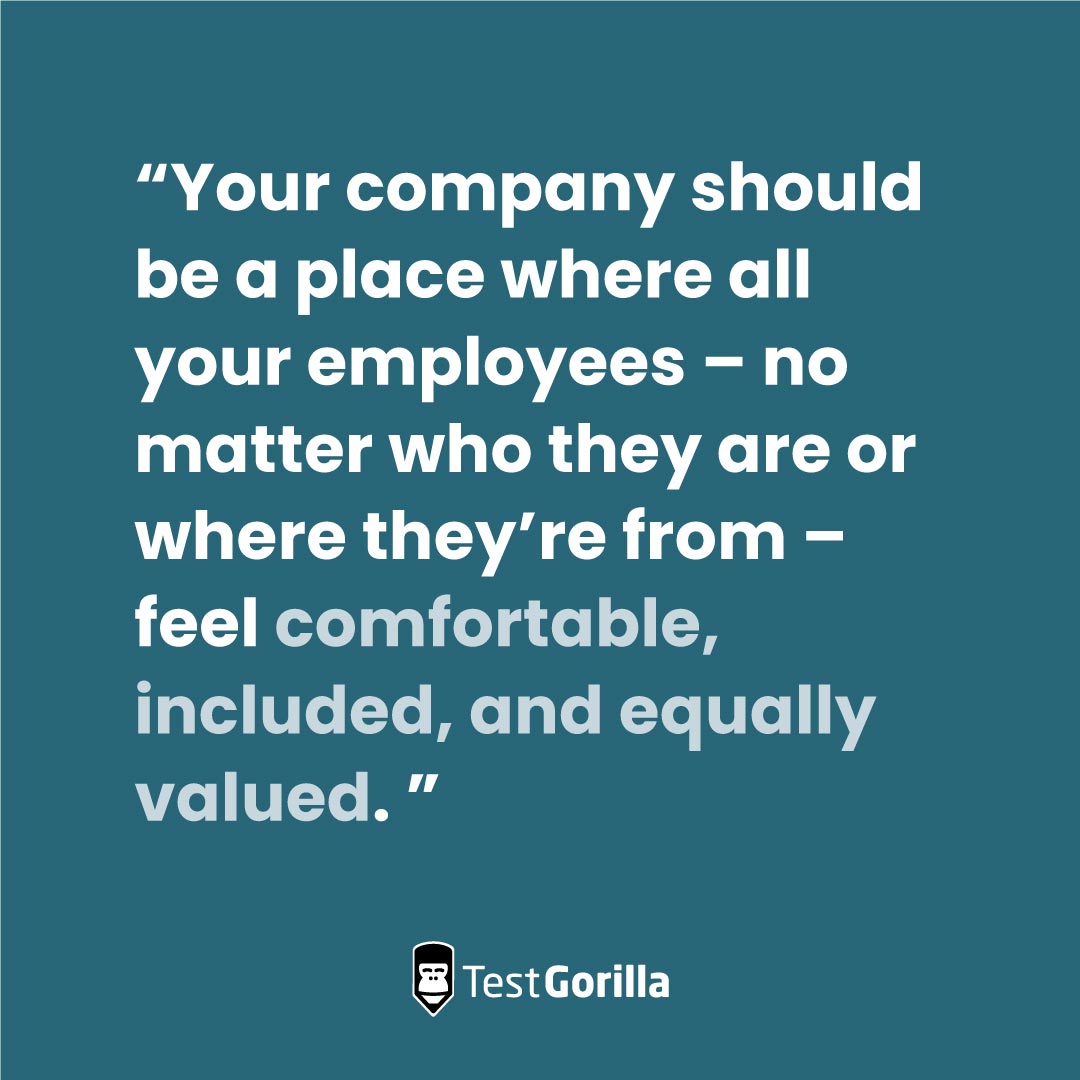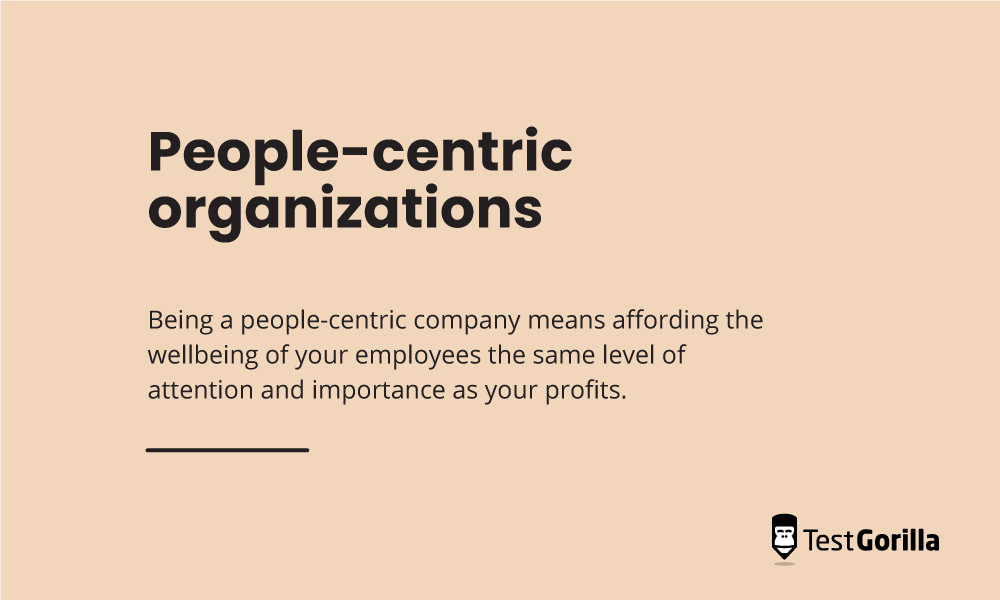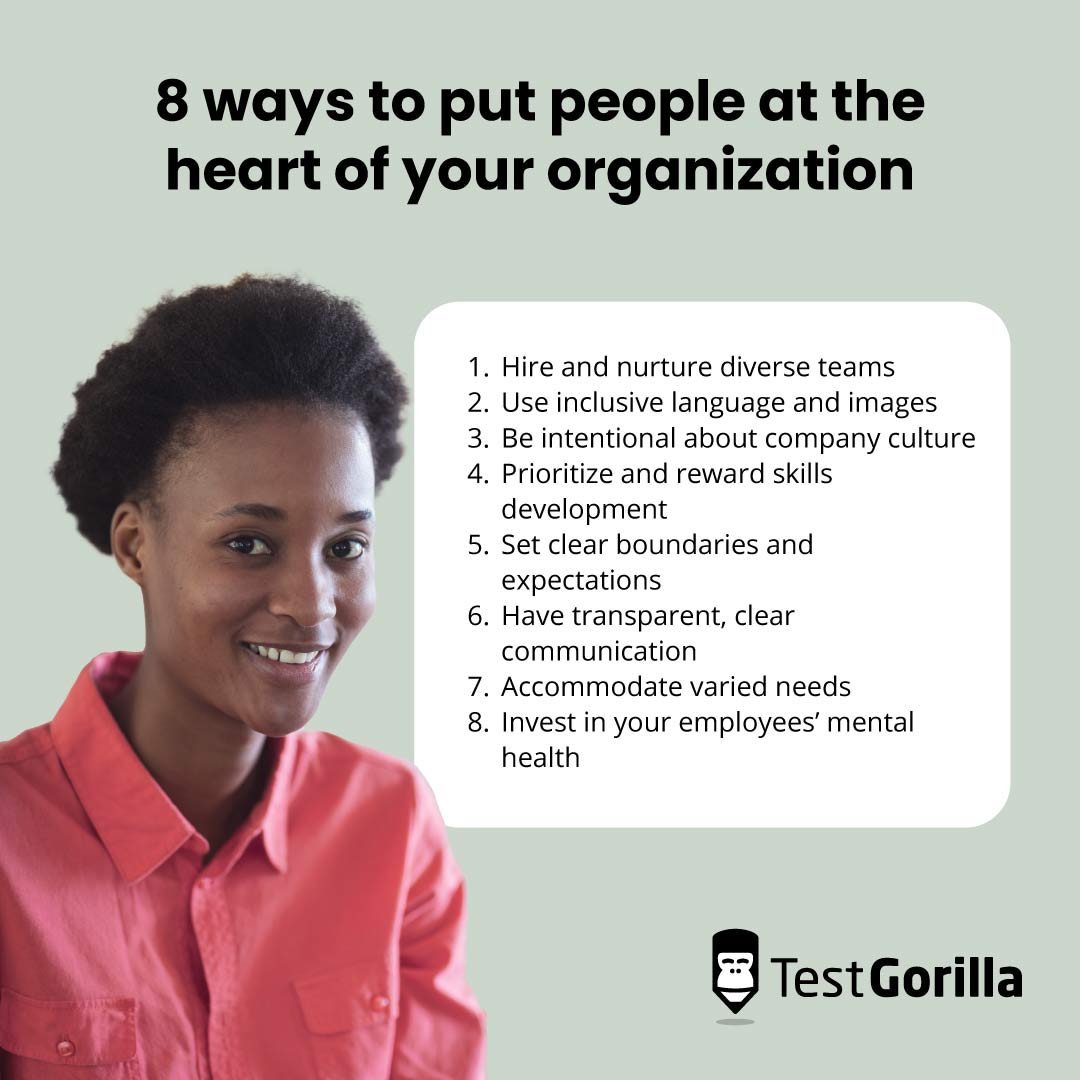Putting the human back into human resources: How to create a people-centric organization
The remote working revolution has opened up global talent pools for companies. But hiring more diverse teams means you need to work harder to create an inclusive environment that accommodates everyone.
With the rise of automated processes and remote work, however, it may feel more challenging than ever to add a human touch to your culture and communications. Especially if your employees never meet in person or don’t interact much.
That’s why you need to make a conscious effort to put people at the heart of your organization.
Your company should be a place where all your employees – no matter who they are or where they’re from – feel comfortable, included, and equally valued.
Creating a people-centric organization will also help you foster a workplace centered on mutual respect and trust that brings out the best in them.
Let’s explore what it means to be a people-centric organization – and eight ways to put your employees at the core of everything you do.
What does it mean to be a people-centric organization?
Every organization has people, but that doesn’t mean every organization prioritizes them. Being a people-centric company means affording the wellbeing of your employees the same level of attention and importance as your profits.
Being a people-centric organization is good for both your people and your business.
Employees that feel connected to and appreciated by their company perform better: Businesses with engaged employees see 23% higher profits than companies with staff who feel unhappy at work.
To be more people-centric, you need to think about what your employees need, both on a personal and professional level. Here are two examples:
Clothing company Patagonia prides itself on offering its employees onsite childcare at two of its largest offices, company-funded health care, sick time, and paid maternity and paternity leave.
Software company Box organizes employee resource and interest groups that help their people feel connected to other members of the organization. It also offers its employees paid VTO (volunteer time off) days to give back to the causes that matter to them.
Unsurprisingly, these companies have A+ culture ratings on Comparably and glowing Glassdoor reviews. But while perks and benefits are key to creating a people-centric culture, it takes more than offering paid vacation to truly put your employees at the heart of your company.
8 ways to put people at the heart of your organization
Here are eight ways to make your organization more people-centric.
1. Hire and nurture diverse teams
One key to being more people-centric is creating a diverse, accepting, and inclusive culture, and the first step towards building a diverse team is eliminating bias from your hiring process. By reducing any discrimination nestling at the point where people enter your company, you set yourself up for diversity and inclusion (D&I) within your workforce.
While implicit bias training may be helpful, it’s often used as a one-stop shop and alone it isn’t enough to eliminate unconscious bias from the hiring process. However, adopting skills-based hiring practices can help you remove unintentional discrimination from your recruitment and hiring efforts.
Skills-based hiring removes emphasis on more arbitrary candidate characteristics like where they grew up or went to school. Instead, you can focus on whether they have the specific skills for the job, regardless of their background and experience.
You can also test for qualities like culture add and soft skills to select people that will make a positive addition to your culture.
In fact, our 2022 State of Skills-Based Hiring report found that 91% of employers that adopted skills-based hiring saw an increase in workplace diversity. Additionally, our data shows that companies who implement skills-based hiring alongside other practices to reduce unconscious bias see the greatest improvements in diversity. Skills-based hiring complements other D&I practices, and vice versa.
Once you’ve built a diverse team, you need to nurture it by prioritizing your employees’ psychological safety. That means creating an environment where everyone feels equally valued, regardless of gender, race, disability, learning style, or sexual orientation. This is crucial to fostering inclusion.
2. Use inclusive language and images
In both your internal and external communications, make sure your language use is thoughtful and inclusive. Some examples of this include using “they” instead of “he/she” and avoiding gender-coded words like “ninja” and “rockstar” in your job listings.
Encourage your employees to include their pronouns in their Slack profile or company bio and use people-centric language when communicating. For example, by using “someone with a disability” instead of “disabled person” to avoid defining that person by their disability. You should also avoid common words that have historically stigmatized mental health, like “crazy” or “psycho”.
Finally, use inclusive visuals on your website and internal communication materials. For example, featuring a variety of gender identities, ethnicities, body types, ages, disabilities, etc.
3. Be intentional about company culture
Your company is only as strong as its culture, so be intentional about the values you set and how you live them each day.
In the words of Logan Mallory, vice president of marketing at Motivosity, creating a people-centric organization “involves creating a culture where employees feel supported, respected, and heard, and their contributions are recognized and valued.”
It’s not enough to just store your values in some internal document that employees see once during onboarding and forget about. You also need to live them from leadership down.
If one of your values is “honesty and integrity,” always be transparent with your employees, even when it’s difficult or uncomfortable. Additionally, when you notice employees exercising these values themselves, provide acknowledgment and show your appreciation for this.
You could review your values in monthly all-team meetings and spotlight members of the team who really lived each value that month. Or you could shout them out in a company-wide “wins” channel on Slack.
Keep in mind that your company’s values don’t have to be one and done: As your culture evolves and improves, you can revisit and modify them to adapt to your team.
4. Prioritize and reward skills development
With more than three-quarters of employees stating they’re more likely to stay with a company that offers continuous training, helping your people reskill and upskill improves the employee experience and may boost retention.
John Everton, technical director at Bravo Benefits, says: “Employees need to feel they have a chance to progress within their organization. Giving them access to resources that enable them to train and educate themselves is a great way to help them feel like their company is invested in them and interested in helping them develop their skills.”
Make an effort to incorporate skills development into your employees’ day-to-day work. Provide regular microlearning or training opportunities so that they can continuously develop their skills and improve in their role. You can also reward employees for meeting development milestones with shoutouts or even bonuses.
When you use skills-based hiring, it’s easier to evaluate the skills people need to effectively learn and upskill, like critical thinking and verbal reasoning. That helps you ensure you’re bringing on the type of employee that will grow with you from day one.
5. Set clear boundaries and expectations
With remote or hybrid work, it’s easier than ever for the lines between personal and professional life to become blurred. You need to set clear boundaries to respect your employees’ work-life balance and avoid burnout.
While you obviously need your team to focus on the company mission, setting boundaries starts with leadership. Encourage managers to take time off, and discourage working long hours or weekends. Make it clear that employees can and should have healthy boundaries with their work.
This also goes for external clients and collaborators. Set up clear guidelines at the beginning of any professional relationship that clearly state that your team will not be available 24/7, but will give its all during working hours. Establishing these boundaries helps you protect your team’s wellbeing and respect everyone’s time.
6. Have transparent, clear communication
To create a people-centric organization, always strive for open and honest communication in how you share information and receive feedback.
That means being transparent about both the good and the bad. Be open about unexpected changes to your team or client roster, which will build trust among your team. But be sure to share wins and positive news as well to foster a sense of shared success and motivation.
And when it comes to feedback, the more the better! Welcome input from your people and make it easy for them to share it anonymously when necessary. You could do this by setting up an anonymous suggestions form on your HR software platform or sending out quarterly feedback surveys that protect your employees’ privacy.
“Listening to and acting on feedback from team members is an essential component of an employee-centric culture. By actively seeking feedback and acting on it, companies demonstrate that they value their employees’ opinions and contributions. This helps create a culture of openness and transparency where team members feel heard and supported.”
– Natasha Maddock, co-founder & non-exec director at Events Made Simple
7. Accommodate varied needs
Not everyone on your team has the same circumstances, so you shouldn’t expect them to work under one-size-fits-all conditions.
Offer flexible working hours to accommodate parents, caregivers, or neurodivergent team members. Also, give your employees a choice of options when it comes to remote and hybrid work, and support employees with health issues that impact their ability to stick to a traditional schedule.
Being accommodating also means adapting to unique working and learning styles. Therefore, you should design your workplace for neurodiversity to accommodate neurodivergent employees.
Lastly, take into consideration each team member’s unique communication preferences and working style. Have employees fill out a questionnaire during their onboarding process and encourage them to be aware of each other’s preferences.
When you know who thrives in collaborative situations and who works best async, you can bring out the best in each of them – and make them feel more comfortable in their role.
8. Invest in your employees’ mental health
You can’t have a people-centric organization without making your employees’ mental health one of your main priorities.
With more than a third of employees experiencing burnout, helping your people care for their mental health puts them at the core of your company.
Provide resources like online therapy sessions through the Oliva Health platform or a wellbeing stipend for self-care activities, mental health support, gym subscriptions, meditation programs, etc.
Most importantly, be accommodating when people are struggling. Make it clear that they can open up when they’ve got too much on their plate, and that help is there when they need to ask for it. Normalize taking a mental health day or asking for a lighter workload when necessary.
The best insights on HR and recruitment, delivered to your inbox.
Biweekly updates. No spam. Unsubscribe any time.
Creating a people-centric organization: The key to thriving companies
With 78% of UK employees alone believing their company owes them more than just compensation, putting people at the center of all you do is essential for retaining them.
Plus, with the ongoing talent war and the Great Resignation, it’s more important than ever to make your organization somewhere candidates and employees want to be.
That means hiring diverse teams and making an effort to put people at the heart of everything you do. Some ways to do that include:
Using skills-based hiring to build an unbiased recruitment process
Building a strong and intentional company culture based on inclusivity
Supporting your employees’ professional development and personal wellbeing
Fostering open and honest communication that starts at leadership and funnels down
Accommodating the unique needs of everyone on your team
By doing all this, you’ll make sure your people feel valued, heard, and appreciated, building a workplace they’re proud to be a part of.
Make people, not resumes, the focus of your hiring process. Skills-based hiring helps you build a more diverse, people-centric organization. Download the 2022 State of Skills-Based Hiring report to learn more.
Related posts
You've scrolled this far
Why not try TestGorilla for free, and see what happens when you put skills first.

















